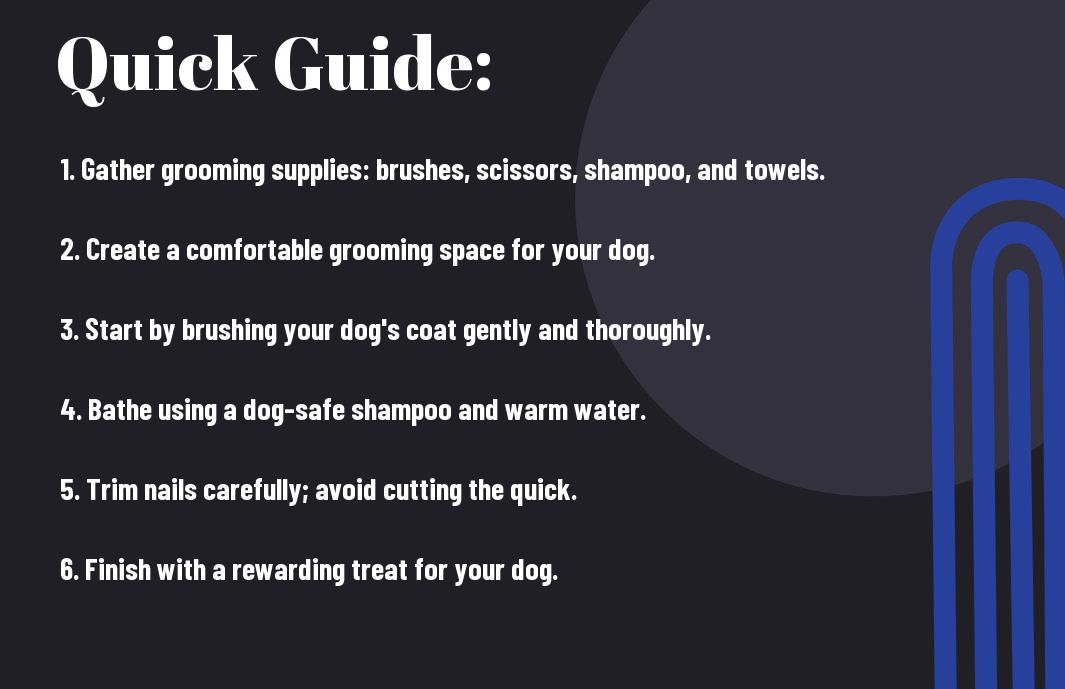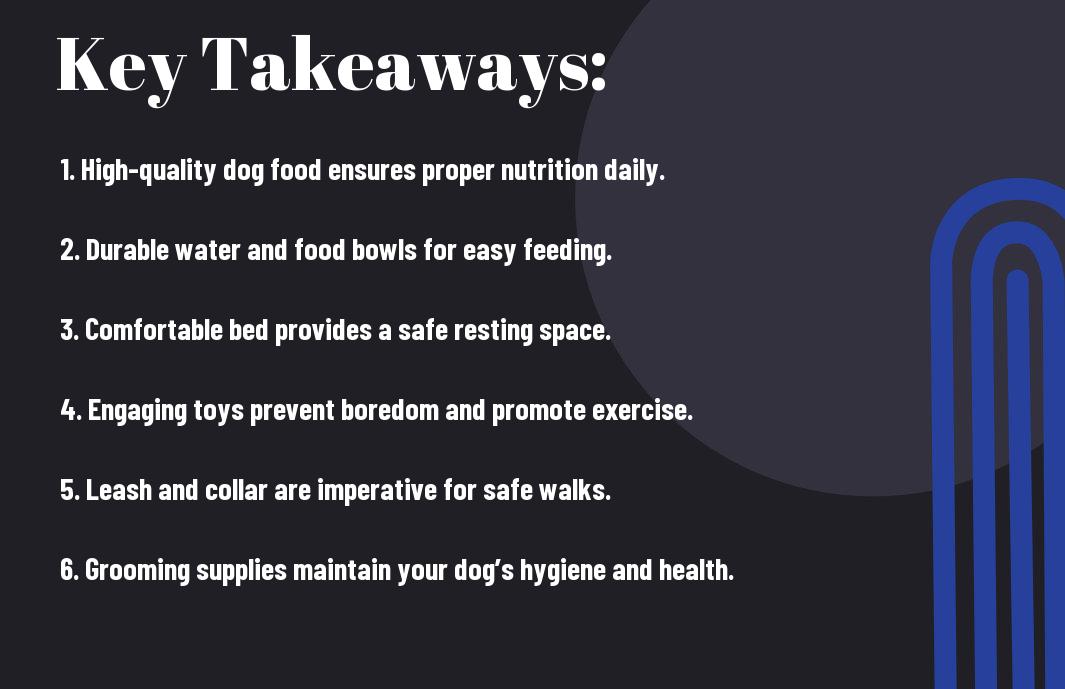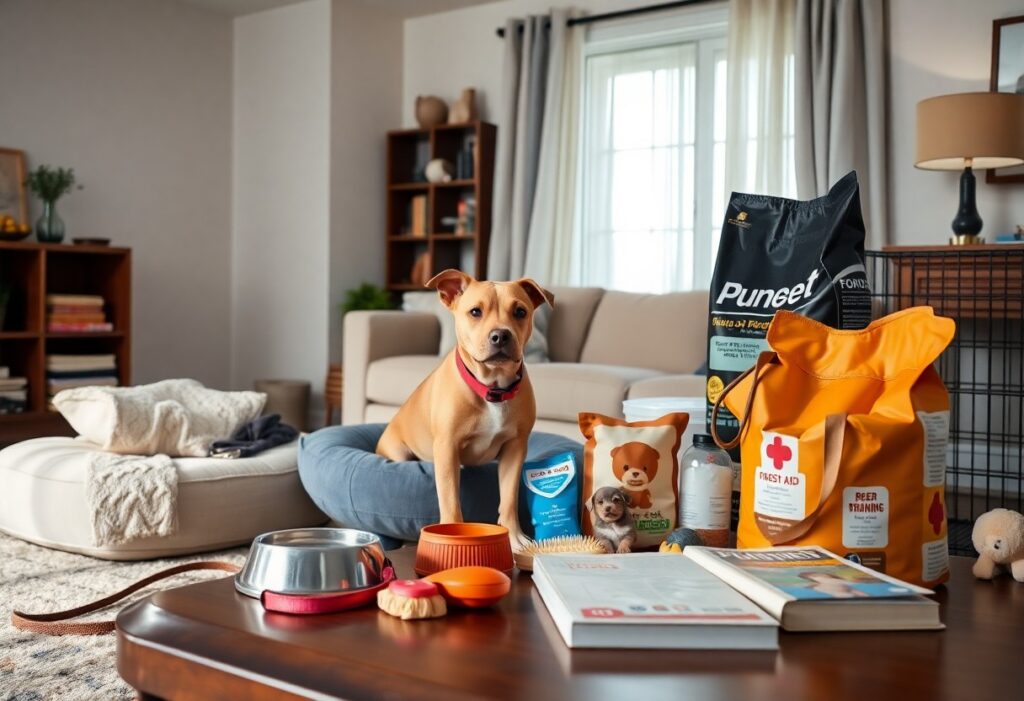Grooming your dog at home can be a rewarding experience that strengthens the bond between you and your furry friend. With proper tools and techniques, you can maintain your dog’s hygiene, appearance, and overall health, while also avoiding the potential dangers of neglect. This guide will provide you with crucial tips and tricks to confidently handle various grooming tasks, ensuring that your pup looks and feels their best right in the comfort of your home.

Understanding Dog Grooming
A fundamental aspect of responsible pet ownership is understanding the nuances of dog grooming. Not only does grooming play a significant role in your dog’s overall health, but it also allows you to bond with your furry friend. You may think of grooming simply as a means to keep your dog looking clean and stylish, but it consists of much more than just a trim and wash. Regular grooming involves attention to several areas including coat care, teeth cleaning, nail trimming, and ear cleaning. By familiarizing yourself with the concept of dog grooming, you’ll be better equipped to keep your four-legged companion healthy and happy.
Importance of Regular Grooming
On a practical level, regular grooming is beneficial for both you and your dog. Not only does it help to manage shedding and dirt, but it can also help identify potential health issues early on. For example, while brushing your dog, you might notice changes in their skin or abnormalities that require veterinary attention. Additionally, grooming sessions can serve as a time for you to check for parasites such as fleas or ticks that could harm your pet’s health.
Moreover, grooming is not just about aesthetics; it plays a vital role in your dog’s mental wellbeing. Regular grooming reinforces your bond with your dog, contributing to their overall happiness. The process provides an opportunity for positive interactions and reinforces trust between you and your pet. Hence, it becomes much more than a chore; it transforms into an important ritual in your dog’s routine.
Various Types of Dog Grooming
Some types of dog grooming focus on different aspects of your dog’s care, each with unique techniques and tools. From simple baths to comprehensive grooming sessions that include nail trimming and coat styling, understanding the variety will help you choose the right approach for your dog. Some common types of grooming to be aware of include:
| Bathing | Washing your dog with appropriate shampoos. |
| Brushing | Removing loose fur and untangling mats from the coat. |
| Nail Trimming | Maintaining nail length for comfort and health. |
| Ear Cleaning | Preventing buildup of dirt and wax in the ears. |
| Styling | Specific cuts tailored to your dog’s breed and needs. |
Grooming also varies by the breed of your dog and their specific needs, highlighting the importance of research and preparation. Various breeds may require unique grooming styles and routines. Familiarize yourself with your breed’s grooming requirements to keep their coat in healthy condition, optimizing their hygiene and appearance.
- Breed-Specific Needs
- Grooming Tools
- Health Benefits
- Trust Building
- Routine Maintenance
Recognizing the types of grooming available will help you tailor the best grooming regimen for your dog.
Essential Grooming Tools
Not every grooming session requires you to have a full arsenal of tools, but certain importants make the process far easier and more effective. The right grooming tools will help you keep your dog looking good and feeling great while also ensuring their health and comfort. Let’s take a look at the must-have tools for grooming your dog at home.
Brushes and Combs
If you want to keep your dog’s coat healthy and free of mats, investing in quality brushes and combs is important. Different types of coats require different tools. For instance, slicker brushes work wonders for removing loose hair and debris from longer-haired breeds, while bristle brushes are excellent for short-haired dogs. Additionally, wide-toothed combs can help you detangle your pet’s hair without causing discomfort.
Using the appropriate brush or comb for your dog’s coat type not only aids in shedding control, but it also promotes a healthy skin and fur by evenly distributing natural oils. Regular brushing can also be a comforting experience for your pet, allowing them to bond with you during grooming sessions.
Nail Clippers and Grinders
Tools for nail grooming are among the most important every dog owner should possess. Quality nail clippers and grinders help maintain your dog’s nail length, preventing discomfort and the potential for injury. Using nail clippers, you can quickly and safely trim your dog’s nails, while grinders allow for smoothing the edges to prevent painful snags.
To effectively and safely trim your dog’s nails, choose the tool that you feel most comfortable using. It’s worth considering that some dogs may have a preference, so observe how your furry friend reacts to each tool type. Efficient nail management positively affects your dog’s overall health by keeping their paws safe and avoiding injury.
Shampoos and Conditioners
Grinders are important for maintaining the coat’s shine and cleanliness, but when it comes to cleansing and conditioning, shampoos and conditioners are just as important. Selecting the right products can make a difference – especially if your pet has allergies or sensitive skin. Look for hypoallergenic options that are free from harsh chemicals, as these are gentle on your dog’s skin.
For instance, a dog-specific shampoo with oatmeal or aloe vera can soothe dry skin, while a moisturizing conditioner helps maintain the coat’s shine and softness. Regular bathing with suitable products will also help maintain skin health and reduce odors.
Ear Cleaning Solutions
If ear hygiene is neglected, it can lead to a variety of health problems. Having the right ear cleaning solutions allows you to effectively maintain the cleanliness of your dog’s ears. Always choose a product specifically designed for dogs, as human products can be too harsh and potentially damaging to their sensitive ears.
Plus, regular ear cleaning can prevent infections and reduce the buildup of wax and debris. It’s a good habit to incorporate ear cleaning into your grooming routine, which, over time, can contribute significantly to your dog’s overall health.
Toothbrushes for Dogs
Now that we’ve covered the basics, let’s talk about your dog’s dental hygiene. Using toothbrushes for dogs is an important part of grooming, aimed at preventing dental diseases. Specially designed toothbrushes have softer bristles and angles that work effectively with a dog’s mouth shape, making it easier for you to brush their teeth without causing discomfort.
Clippers should not solely occupy your grooming toolkit; make dental care a routine part of your regimen. Regular brushing not only freshens their breath but can also avert serious health issues down the line, as oral hygiene has a direct correlation with overall health.

The Ultimate Guide To Dog Grooming At Home
Now, it’s time to get into the nitty-gritty of grooming your dog at home. This step-by-step guide will help you transform the grooming process into a bonding experience with your furry friend. To make things easier, we’ve broken it down into important steps and details for you to follow.
Step-by-Step Guide to Grooming Your Dog
| Step | Description |
| 1. Preparing Your Dog for Grooming | Gather your supplies and create a positive atmosphere. |
| 2. Bathing Your Dog | Use appropriate shampoo and ensure the temperature is comfortable. |
| 3. Drying Techniques | Use towels and gentle drying methods suitable for your dog’s coat. |
| 4. Brushing Your Dog’s Coat | Choose the right brush and technique according to your dog’s fur type. |
| 5. Nail Trimming Process | Familiarize yourself with your dog’s nails and use the right tools. |
| 6. Cleaning Ears and Teeth | Employ gentle cleaning methods to maintain your dog’s health. |
Preparing Your Dog for Grooming
Clearly, setting the stage for grooming starts with having all your tools ready and ensuring your dog feels comfortable. Begin by choosing a quiet space where your dog feels safe. You will need items like brushes, clippers, dog shampoo, towels, and treats to reward good behavior.
Next, establish a calm routine to help your dog acclimate to the grooming process. This can include short practice sessions where you touch their paws or run a brush through their coat. Using treats and praise creates a positive atmosphere, making the grooming less stressful for both of you.
Bathing Your Dog
Now, the bathing process should be both effective and enjoyable for your dog. Begin by brushing your dog’s coat to remove any loose hair and mats, which will make bathing easier. Use lukewarm water and dog-specific shampoo to avoid skin irritation. Gently wet your dog’s body, apply the shampoo, and lather well, avoiding their eyes and ears.
After rinsing out all the shampoo, you can also use a conditioner suitable for your dog’s coat type if needed. This will leave their fur soft and manageable, making the next grooming steps easier. Bathing is not just about cleanliness; it also helps in checking for skin issues that may need attention.
Bathing your dog regularly contributes to their overall hygiene, making it easier to manage shedding and skin conditions. Use a non-slip mat in the tub to keep your dog steady, and maintain a soothing voice throughout the process to reassure them.
Drying Techniques
StepbyStep, let’s discuss how to dry your dog after a bath. Start by gently towel-drying to absorb excess water. If your dog enjoys it, you can use a low-heat pet dryer, being cautious to keep it at a safe distance to avoid burns. Be patient; some dogs may feel frightened by the noise or sensation of a dryer, so pay attention to their comfort level.
Additionally, ensure you dry hard-to-reach areas like underbelly, paws, and behind the ears thoroughly. These areas can retain moisture, potentially leading to skin problems if neglected.
Guide with a focus on your dog’s comfort and make the drying process a part of your grooming routine, as a well-dried dog will have a healthier coat.
Brushing Your Dog’s Coat
Now that you’ve bathed and dried your dog, let’s focus on brushing. Choose a brush that suits your dog’s coat type; for instance, slicker brushes are great for long-haired breeds, while bristle brushes work well on shorter coats. Grooming your dog not only removes loose hair and dirt but also distributes natural oils, promoting a shiny coat.
Brush in the direction of hair growth and be gentle to avoid causing pain. Daily brushing is ideal for preventatively managing tangles and reducing shedding, particularly for long-haired dogs.
Grooming your dog’s coat helps establish a strong bond between you both and is a great way to check for any unusual lumps, bumps, or skin irritations that may need attention.
Nail Trimming Process
Clearly, trimming your dog’s nails is an important part of grooming that can be intimidating for many pet owners. It’s vital to use good-quality dog nail clippers or a grinder and to identify the quick—the area with blood vessels and nerves—before you begin. Trim just a little bit at a time, taking breaks if your dog seems stressed.
Use treats to reward your dog after each paw is done, creating a positive experience around nail trimming. If you’re unsure or your dog has dark nails, consulting a professional groomer or veterinarian for guidance may help ease anxiety.
Trimming nails regularly helps prevent painful splitting and cracking of the nails and keeps your dog comfortable during walks. An effective trimming process not only contributes to your dog’s health but also offers a bonding opportunity.
Cleaning Ears and Teeth
Your dog’s ear and dental health are just as important as their coat and nails. Gently check their ears for any signs of dirt, wax buildup, or infections. Use a vet-recommended ear cleaning solution, and a cotton ball to softly wipe away any debris. Be careful not to insert anything deep into their ears.
For dental care, brushing your dog’s teeth regularly with canine toothpaste helps prevent tartar buildup and gum disease. Consider incorporating dental chews or toys as part of your oral health routine.
Process the cleaning of ears and teeth as a regular part of your dog’s grooming schedule. This will lead to a healthier and happier pet while reinforcing the bond that you share with them.
Tips for Successful Grooming
Many dog owners find grooming their pets at home a daunting task, but with the right tips and techniques, it can become a rewarding experience. Here are some important tips to ensure your dog grooming sessions are successful:
- Establish a grooming routine that works for you and your dog.
- Utilize the right tools for your dog’s specific coat type.
- Always reward your dog with treats for good behavior during grooming.
- Ensure proper lighting in your grooming area.
- Stay patient and calm to keep your dog relaxed during the process.
Thou can make dog grooming an enjoyable bonding experience with the right approach.
Creating a Comfortable Environment
Even though your dog may enjoy being pampered, it’s important to create a comfortable environment for grooming. Make sure you’ve chosen a quiet place in your home, away from distractions and noise that could stress your pet. A non-slip surface is ideal, as it helps your dog feel secure while you groom them.
Additionally, consider having all your grooming tools organized and within reach. This will help you to avoid leaving your dog unattended while you scrounge around for supplies. Providing a cozy blanket or bed in the grooming area can also make your pet feel more at ease.
Handling Behavioral Challenges
Even the best-behaved dogs may exhibit some behavioral challenges during grooming sessions. It’s important to understand your dog’s temperament and emotions to manage any potential issues effectively. If your dog is afraid of the sound of clippers or brushes, introducing these tools slowly and at a distance can mitigate anxiety.
Always remain calm and speak to your pup in a soothing voice to ensure they feel safe. If your dog tries to escape or becomes agitated, take a break and allow them to regain their composure. Gradually desensitizing them to grooming tools can certainly help ease their fears.
Creating an engaging environment can also assist your dog in remaining calm during their grooming sessions. Play soft music or give them a favorite chew toy to divert their attention from the grooming process. Positive reinforcement through treats and praise can go a long way in helping your dog associate grooming with a rewarding experience.
Grooming Frequency Recommendations
Grooming your dog regularly is important to maintain their coat health and prevent matting. Grooming frequency largely depends on your dog’s breed and coat type. Short-haired breeds often require less frequent grooming compared to long-haired ones. Generally, most dogs benefit from grooming sessions every 4 to 8 weeks, while some may need weekly brushes to keep their coats in top shape.
Ensuring you stay consistent with your grooming routine will not only contribute to your dog’s appearance but also their overall health. Neglecting grooming can lead to skin irritations and mats, which can cause discomfort or pain for your furry friend.
Tips for determining grooming frequency can include observing your dog’s coat condition. If you notice excessive shedding or tangles, it might be time to increase your grooming sessions. Additionally, consult with your vet or professional groomer for tailored advice for your specific breed.
Seasonal Grooming Tips
While each season presents unique challenges and needs for your dog’s grooming, being prepared can ensure your dog looks and feels their best year-round. During the summer months, regular grooming helps your dog cope with the heat by removing excess undercoat and preventing matting. In winter, consider grooming your dog’s paws and trimming excess fur to prevent ice build-up.
- In summer, consider a shorter cut to keep your dog cool.
- For winter, make sure to check for frostbite on paws.
- Monitor your dog’s skin and coat for dryness during colder months.
- All seasons require proper brushing to keep mats at bay.
Assume that grooming routines may vary based on the climate and seasonal changes you encounter.
With each change in season, pay closer attention to how your dog’s coat responds. If you notice any changes in texture or behavior, feel free to adjust grooming practices to accommodate their needs.
- During spring, prepare for shedding and increase brushing sessions.
- In autumn, provide a thorough grooming to remove fall debris from the coat.
Assume that adjusting your grooming techniques as seasons change is vital for maintaining your dog’s coat health.
Factors to Consider When Grooming
For successful grooming at home, there are several important factors you need to consider to ensure the best experience for both you and your dog. A well-thought-out grooming routine can prevent issues like matting, skin irritation, and general discomfort for your pet. Here are some key aspects to keep in mind:
- Dog Breed and Coat Type
- Age and Health of Your Dog
- Allergies or Skin Conditions
Dog Breed and Coat Type
You must consider your dog’s breed and coat type when planning their grooming routine. Different breeds have different requirements based on the texture and length of their fur. For instance, long-haired breeds like the Yorkshire Terrier may require frequent brushing to prevent tangles, while short-haired breeds like the Beagle may need less frequent grooming but benefit from regular brushing to remove loose hair and dander. Understanding your dog’s specific needs will help you choose the right tools and techniques.
Additionally, many dogs have coats that shed more during shedding seasons. This means you may need to adjust your grooming schedule during certain times of the year, as well as invest in appropriate grooming tools aimed at reducing shedding. By aligning your grooming approach with your dog’s breed characteristics, you can maintain their coat health effectively.
Age and Health of Your Dog
If your dog is a puppy or a senior, their grooming needs will differ significantly. Puppies generally require a gentle approach to grooming, as they may be more sensitive to handling. As they grow, introducing grooming gradually can help make it a positive experience for them. On the other hand, senior dogs may have physical limitations such as arthritis or mobility issues, making certain grooming tasks more challenging. It’s important to modify your techniques according to their age to avoid causing discomfort.
Understanding the specific health conditions your dog may have is equally important. If your dog has a medical issue, such as obesity or joint pain, it can affect their grooming routine and the positions you can place them in. Regular check-ups with your vet can also provide you with important insights into how their current health status impacts grooming.
With elderly dogs or those with underlying health issues, it might be beneficial to discuss a personalized grooming plan with your vet. This plan can involve selecting specific tools or techniques that minimize discomfort while still keeping your dog looking and feeling their best.
Allergies or Skin Conditions
The presence of allergies or skin conditions can significantly influence your grooming approach. If your dog suffers from allergies, using the correct type of shampoo is important. Hypoallergenic products can help avoid causing further irritation. Regular grooming may also assist in removing allergens from your dog’s coat, supporting their overall skin health. Additionally, you should be cautious with how often you bathe them; over-bathing can strip the natural oils from their skin, exacerbating skin conditions.
Understanding your dog’s specific allergies or sensitivities can help you choose the right products. Consulting with a veterinary dermatologist may be necessary to pinpoint the exact nature of the allergies and develop a comprehensive grooming routine that minimizes flare-ups while keeping your dog’s coat in excellent condition.

Pros and Cons of Home Grooming
Unlike taking your furry friend to a professional groomer, home grooming has its own set of advantages and disadvantages. It’s important for you to weigh these factors when deciding on the best grooming practice for your dog.
Pros and Cons of Home Grooming
| Pros | Cons |
|---|---|
| Cost-effective | Requires time and effort |
| Convenient scheduling | May lack professional expertise |
| Strengthens your bond with your dog | Risk of injuries if not careful |
| Control over grooming products used | Potential stress for your pet |
| Flexible grooming frequency | Need for proper tools and equipment |
| Ability to monitor your dog’s health closely | Not all breeds are suitable for home grooming |
Advantages of Grooming at Home
With home grooming, you can take advantage of cost savings by avoiding the fees associated with professional grooming services. This allows you to invest in premium grooming products or tools, making grooming a less financial burden. Additionally, home grooming provides you with the flexibility to set your schedule, providing the convenience that busy pet owners often appreciate.
Moreover, grooming at home strengthens the bond between you and your dog. The time spent together can help build trust, making your furry friend feel more comfortable and secure in your presence. You gain firsthand knowledge of your dog’s specific needs and preferences, giving you greater control over how their coat is maintained and managed.
Disadvantages and Challenges
Now, while home grooming has many benefits, it also poses several challenges that you should consider. One of the primary drawbacks is the time commitment; grooming can take significantly longer when done at home, especially if you or your dog are new to the process. Additionally, without the right expertise, you may not achieve the same level of precision and care that a professional groomer would provide.
Plus, injuries are always a risk if you are not careful, particularly when handling sharp tools like clippers and scissors. On top of that, many dogs become stressed during grooming sessions, making it necessary for you to develop proper techniques to ensure your pet remains calm and comfortable. It’s important to evaluate your dog’s temperament and grooming needs before committing to home grooming.
When to Seek Professional Grooming Services
Even if you prefer home grooming, some situations necessitate a trip to a professional. If your dog has a particularly difficult coat or requires specialized grooming techniques, it may be best to leave it to the experts. Additionally, dogs that experience significant anxiety during grooming should be handled by professionals trained to manage such cases effectively.
A more complicated grooming process may be required for breeds with unique grooming needs. If you notice your dog has skin conditions or significant matting, professional groomers possess the skills and tools needed to address these issues safely. By establishing a balance between home grooming and professional services, you can provide the best care for your furry companion.
To wrap up
Taking this into account, your journey into home dog grooming can be both enjoyable and rewarding. By understanding your dog’s specific grooming needs and utilizing the right tools and techniques, you can create a positive experience for both you and your furry friend. Regular grooming not only keeps your dog’s coat healthy and free of mats but also strengthens the bond between you as you spend quality time together. Be patient and consistent, as developing a grooming routine will take time but will yield significant benefits for your dog’s overall health and well-being.
As you launch on this grooming endeavor, don’t hesitate to seek out resources, such as instructional videos or professional advice, to enhance your skills. The ultimate goal is to ensure your dog feels comfortable and looks their best while being well cared for. With practice and attentiveness, you can transform grooming from a chore into a delightful part of your dog’s care regimen, elevating their quality of life and strengthening your relationship.
Q: What tools do I need for grooming my dog at home?
A: To effectively groom your dog at home, you’ll require several necessary tools. Start with a high-quality brush suitable for your dog’s coat type, which could include a slicker brush, bristle brush, or comb. You’ll also need nail clippers specifically designed for dogs, a bathing brush for scrubbing during bath time, and dog shampoo that suits your dog’s skin type. Additionally, consider having towels, a grooming table or mat, and ear cleaning solution on hand to make the process smoother. These tools will help you maintain your dog’s coat and hygiene, ensuring they look their best.
Q: How often should I groom my dog at home?
A: The frequency of grooming depends on your dog’s breed, coat type, and lifestyle. Generally, long-haired breeds may require grooming every 4 to 6 weeks to prevent matting, while short-haired dogs might only need a good brush and bath every couple of months. Regular brushing (at least once a week) can help to remove loose fur, dirt, and tangles. Additionally, you should check your dog’s nails monthly and clean their ears during your grooming sessions. Establishing a consistent grooming schedule tailored to your dog’s needs will help keep them healthy and comfortable.
Q: How can I make grooming a positive experience for my dog?
A: To ensure grooming is enjoyable for your dog, start by creating a calm and inviting grooming environment. Begin with short grooming sessions and gradually increase the duration as your dog becomes more comfortable. Use treats and praise throughout the process to reinforce positive behavior. Familiarize your dog with the grooming tools beforehand, allowing them to sniff and explore them at their own pace. Providing breaks and using gentle handling can also help reduce anxiety. By making grooming a relaxing and rewarding experience, you can strengthen the bond with your dog and ease any fears they may have.










